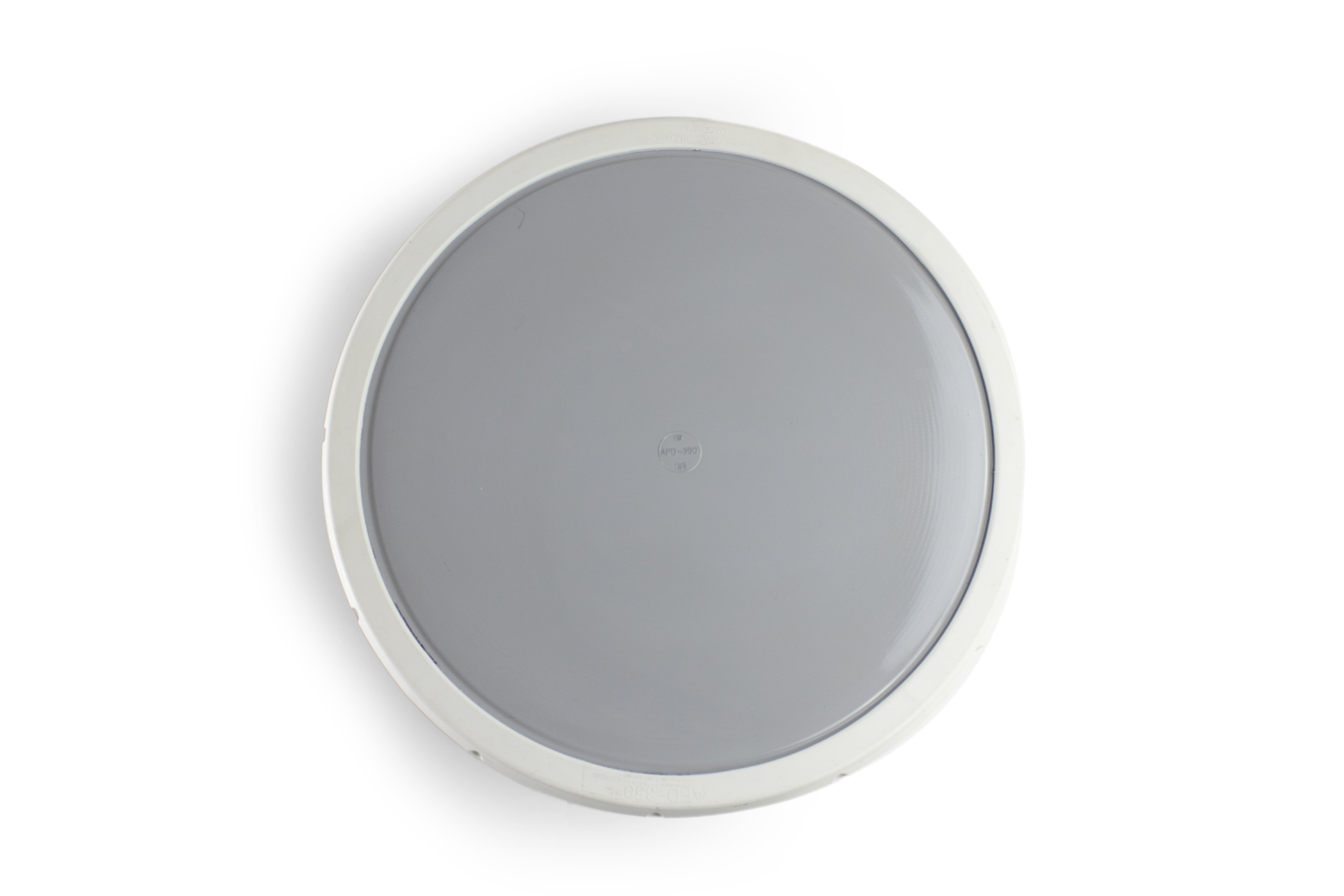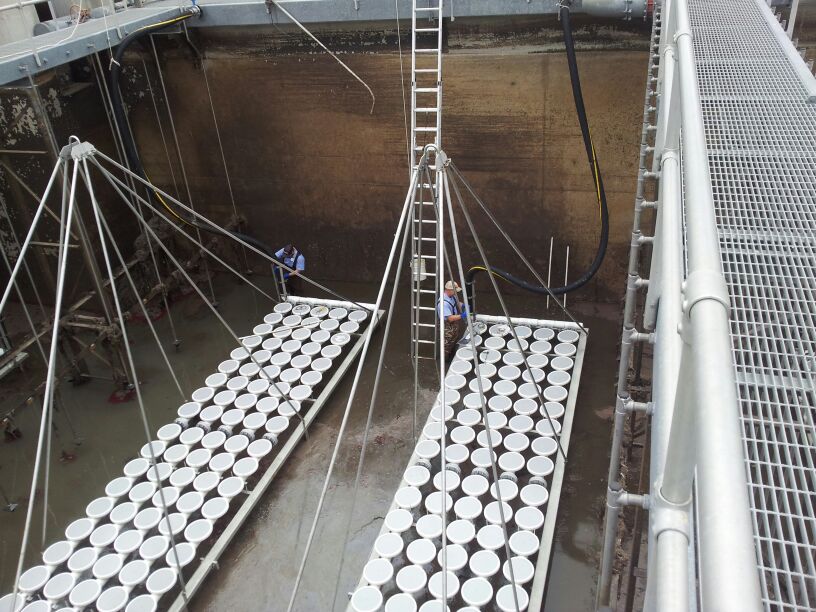Pros & Cons Of High Capacity Fine Bubble Diffusers
By: Tom Frankel
Post Date: April 26th 2017
We classify wastewater aeration diffusers into two types – Fine Bubble and Coarse Bubble. Within Fine Bubble, there are needle-perforated panels, standard disc and tubes with ~1mm perforations, and larger perforations, typically 2mm, sometimes referred to as medium bubble and other times as fine bubble diffusers.
Performance
The performance of the standard fine bubble diffusers is fairly well understood by the market. Typically  they provide 2%/ft — 6.5%/meter standard oxygen transfer efficiency (SOTE), they have a pressure drop of approximately 12″ WG — 30 mbar when new, and they are usually installed in a full floor grid, at airflux rates of 2.5-6.0 SCFM/sqft — 50-120 Sm3/hr-m2, and they produce bubbles in a range of diameters from 1 to 3 mm.
they provide 2%/ft — 6.5%/meter standard oxygen transfer efficiency (SOTE), they have a pressure drop of approximately 12″ WG — 30 mbar when new, and they are usually installed in a full floor grid, at airflux rates of 2.5-6.0 SCFM/sqft — 50-120 Sm3/hr-m2, and they produce bubbles in a range of diameters from 1 to 3 mm.
Less well understood is the performance of fine bubble diffusers with needle perforations or large perforations, sometimes nicknamed ultra-fine bubble and high capacity or medium bubble, respectively. We will save the discussion of panel/strip diffusers for another post, and concentrate only on the high capacity products here.
When To Use Fine Bubble Diffusers
There are some strong technical reasons to select high capacity diffusers. If you anticipate severe fouling, larger slits may give you a longer time to failure or cleaning. If you are installing diffusers in a very deep tank (over 25 ft — 8m), small perforations can be less efficient. If you are converting from coarse bubble to fine bubble diffusers and re-using existing blowers, larger slits may help you reuse existing pressure-limited blowers.
Likewise, there are good reasons to use standard fine bubble diffusers, and when in doubt, this should be your default choice.
Diffuser orifice size controls the uniformity of air distribution across your grid. A small orifice typical of a standard fine bubble diffuser typically allows a significant turn-down of airflow to accommodate lower oxygen requirements overnight. There is a nonlinear relationship between orifice size and minimum airflow rate per diffuser to achieve uniformity. We consider even a 1 mm difference as significant when it relates to turndown. Consider the example of a 9″/270mm disc diffuser – a standard version may have a 5mm orifice, while a high capacity diffuser has a 10mm orifice. The 5mm orifice has a minimum airflow rate for uniform distribution of 0.5 SCFM — 0.9 Sm3/hr while the 10mm orifice needs 2.5 SCFM — 4.3 Sm3/hr. Even if you use half the quantity of diffusers when you select the high capacity option, you have just reduced your turndown by a factor of 2.5.
The modulus of elasticity of an elastomer is a measurement of the force with which an elongated piece of rubber tries to return to its original relaxed shape. Fine bubble membranes benefit from this; if you were to watch a slit release a bubble under slow motion, you would see that it cracks open and then shuts. The bubble sits on the rubber surface for an instant or longer, depending on the hydrophobicity of the rubber or biofilm, releases, and the whole process repeats itself in an instant. The production of a plume of small bubbles across the surface of a single diffuser occurs by carefully controlling tight manufacturing tolerances in the membrane compounding, mixing, molding and slit cutting process. However it also requires that we respect physics and allow the slit sufficient time to open and close. If we cut large, deep slits, and blast air through the membrane, in essence we are creating an oval hole at each slit location that opens but never quite closes. Bubble sizes eminating from large slits operated at high flux rates are invariable large; just like Coarse Bubbles, they rise quickly to the water surface and they have a small aggregate surface area.
 Hydraulic Considerations
Hydraulic Considerations
There are also hydraulic considerations. It would be economical to purchase and easy to maintain an aeration system if it consisted of a single large diffuser in the center of an tank. We can all imagine the problems that this method would create, like a tall fountain that may be visually pleasing, especially when lit up at night, but one that provides poor distribution of oxygenated water, and a very fast bubble ascent velocity with lots of coalescence. In this scenario, we are pumping water to the surface more effectively than providing oxygen mass transfer.
A much better approach would be to cover the entire floor with membranes, and uniformly distribute air to all corners, without any space to walk. This is also impractical, but it does establish the ideal scenario for oxygen mass transfer. If we are able to create an environment in the tank without dead zones, where water that is entrained by the bubble columns and carried to the surface has to follow a tortuous path back to the floor, then we have done some good. Laminar flows from top to bottom, often called spiral flows, are attracted to bubble columns because the bubble columns have a low average specific gravity. When water is allowed to recirculate quickly down into the basin, it finds bubble columns, causes plume compression and bubble coalescence. These result in larger bubbles and a faster rising plume, lowering oxygen mass transfer efficiencies in the process. Since we can’t cover the entire floor, we try to cover as much as we can and leave reasonable gaps that allow access for maintenance, where tank sizing allows. (Sometimes tanks are constructed too large for the flow and load, and we end up with larger spaces between diffusers and pipes than is ideal).
Mechanical Benefits Of Fine Bubble Diffusers
Finally, there are mechanical benefits to using diffusers within their standard range of operation. Fine bubble membranes have been in the market for over 20 years, and there are many plants with diffusers older than 10 years still in operation. They don’t have serious problems with the membranes, holders, or attachments to pipe. When you double, triple or quadruple, the airflow rate to each diffuser, at the very least, you are creating more turbulence at the diffuser mount, and wearing the membrane in a different way. Stress cracking of plastic parts, creep, tearing and drying of rubber parts have to be considered.
In most cases, selecting standard fine bubble diffusers will provide the owner with a system that has a significant turn-down and turn-up, provides high efficiency oxygen transfer and sufficient mixing to keep solids in suspension, and lasts a long time. When a common sense approach is taken that considers both capital costs and operating costs, except in a few notable circumstances mentioned above, it is difficult to justify the selection of high capacity fine bubble diffusers. In many cases, the high capacity system will carry a 20%+ penalty in lifetime operating costs due to lack of turndown and lower transfer efficiency. When 60-70% of the entire plant’s energy consumption comes from the aeration tank, this is a big number. Owners should speak up and demand products and systems that provide them with a good long-term value proposition.

Mr. Frankel co-founded SSI in 1995 with experience in design and distribution of engineered systems. He is in charge of sales, marketing and operations in the company. Mr. Frankel holds multiple US patents related to diffusers. He is a graduate of Washington University in St. Louis.

